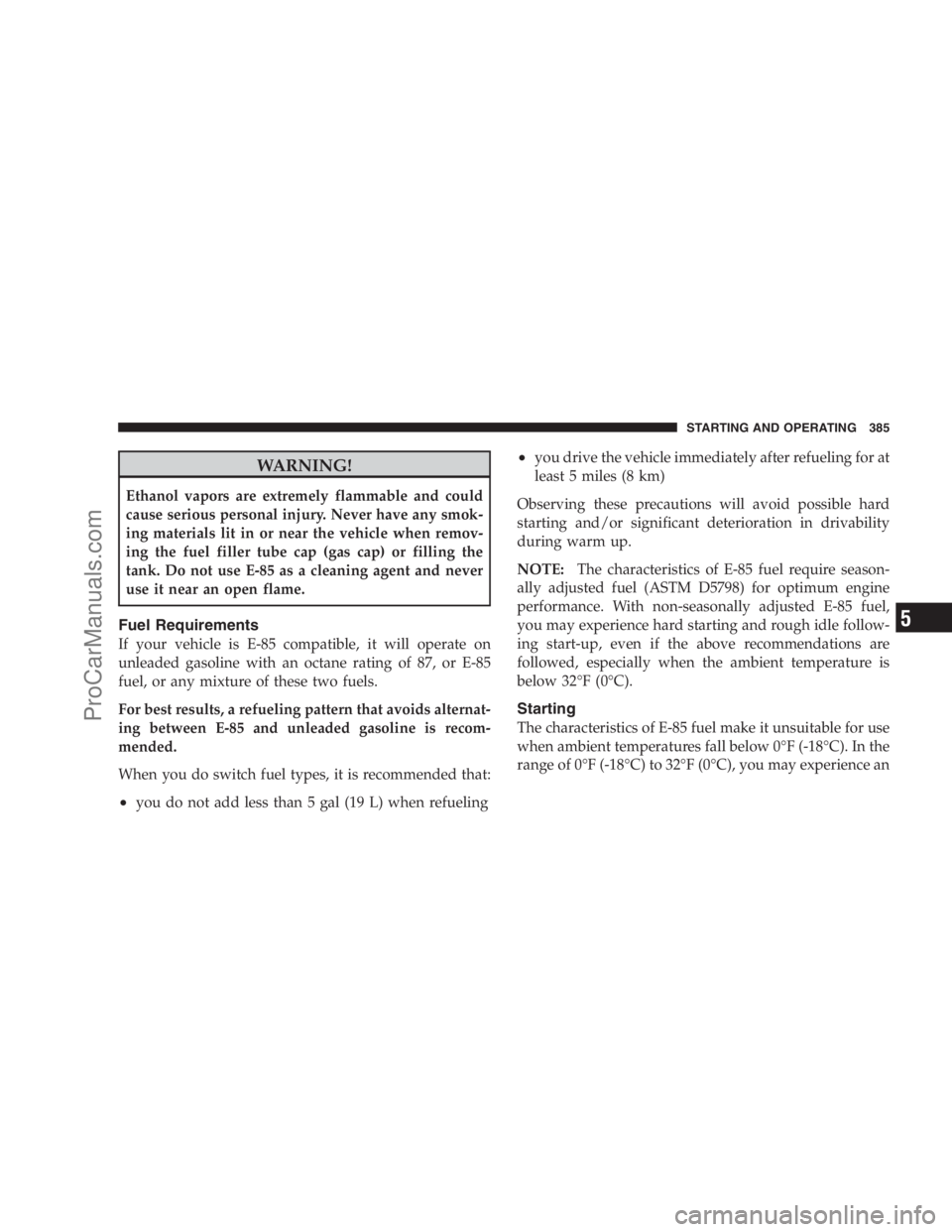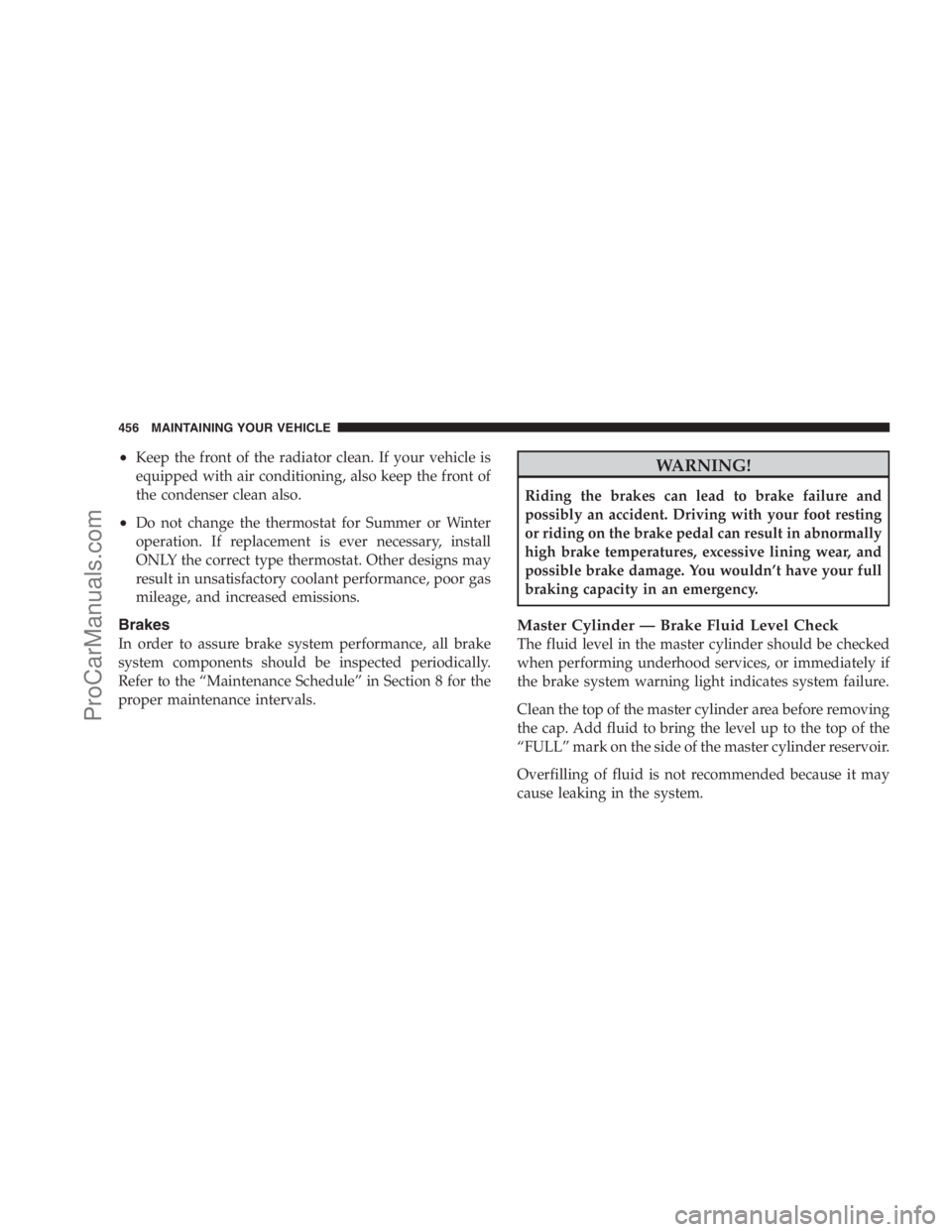Page 387 of 534

WARNING!
Ethanol vapors are extremely flammable and could
cause serious personal injury. Never have any smok-
ing materials lit in or near the vehicle when remov-
ing the fuel filler tube cap (gas cap) or filling the
tank. Do not use E-85 as a cleaning agent and never
use it near an open flame.
Fuel Requirements
If your vehicle is E-85 compatible, it will operate on
unleaded gasoline with an octane rating of 87, or E-85
fuel, or any mixture of these two fuels.
For best results, a refueling pattern that avoids alternat-
ing between E-85 and unleaded gasoline is recom-
mended.
When you do switch fuel types, it is recommended that:
•you do not add less than 5 gal (19 L) when refueling
•you drive the vehicle immediately after refueling for at
least 5 miles (8 km)
Observing these precautions will avoid possible hard
starting and/or significant deterioration in drivability
during warm up.
NOTE:The characteristics of E-85 fuel require season-
ally adjusted fuel (ASTM D5798) for optimum engine
performance. With non-seasonally adjusted E-85 fuel,
you may experience hard starting and rough idle follow-
ing start-up, even if the above recommendations are
followed, especially when the ambient temperature is
below 32°F (0°C).
Starting
The characteristics of E-85 fuel make it unsuitable for use
when ambient temperatures fall below 0°F (-18°C). In the
range of 0°F (-18°C) to 32°F (0°C), you may experience an
STARTING AND OPERATING 385
5
ProCarManuals.com
Page 426 of 534

CAUTION!
For vehicles equipped with Stow ’n Go seating, the
winch mechanism is designed specifically to stow a
compact spare tire only. Do not attempt to use the
winch to stow the full size flat tire, or any other
full-size tire. Vehicle damage may result.
JUMP-STARTING PROCEDURE
WARNING!
•Do not attempt to push or tow the vehicle to get it
started. Vehicles equipped with an automatic
transmission cannot be started this way. Unburned
fuel could enter the catalytic converter and once
the engine has started, ignite and damage the
converter and vehicle.
(Continued)
WARNING! (Continued)
•If the vehicle has a discharged battery, booster
cables may be used to obtain a start from another
vehicle. This type of start can be dangerous if done
improperly, so follow this procedure carefully.
•Battery fluid is a corrosive acid solution; do not
allow battery fluid to contact eyes, skin or cloth-
ing. Do not lean over a battery when attaching
clamps, or allow the clamps to touch each other. If
acid splashes in eyes or on skin, flush the contami-
nated area immediately with large quantities of
water.
•A battery generates hydrogen gas, which is flam-
mable and explosive. Keep all flames and sparks
away from the vent holes. Do not use a booster
battery or any other booster source with an output
that exceeds 12-Volts.
(Continued)
424 WHAT TO DO IN EMERGENCIES
ProCarManuals.com
Page 458 of 534

•Keep the front of the radiator clean. If your vehicle is
equipped with air conditioning, also keep the front of
the condenser clean also.
•Do not change the thermostat for Summer or Winter
operation. If replacement is ever necessary, install
ONLY the correct type thermostat. Other designs may
result in unsatisfactory coolant performance, poor gas
mileage, and increased emissions.
Brakes
In order to assure brake system performance, all brake
system components should be inspected periodically.
Refer to the “Maintenance Schedule” in Section 8 for the
proper maintenance intervals.
WARNING!
Riding the brakes can lead to brake failure and
possibly an accident. Driving with your foot resting
or riding on the brake pedal can result in abnormally
high brake temperatures, excessive lining wear, and
possible brake damage. You wouldn’t have your full
braking capacity in an emergency.
Master Cylinder — Brake Fluid Level Check
The fluid level in the master cylinder should be checked
when performing underhood services, or immediately if
the brake system warning light indicates system failure.
Clean the top of the master cylinder area before removing
the cap. Add fluid to bring the level up to the top of the
“FULL” mark on the side of the master cylinder reservoir.
Overfilling of fluid is not recommended because it may
cause leaking in the system.
456 MAINTAINING YOUR VEHICLE
ProCarManuals.com
Page 515 of 534

Automatic Headlights.................... 174
Automatic Temperature Control (ATC)......... 310
Automatic Transaxle...................... 327
Adding Fluid......................... 459
Fluid Level Check...................... 459
Interlock System....................... 328
Selection Of Lubricant................458,481
Shifting............................. 329
Special Additives...................... 460
Automatic Transmission................458,460
Adding Fluid......................459,460
Fluid and Filter Changes................. 460
Fluid Change......................... 460
Fluid Level Check...................... 459
Fluid Type........................458,481
Battery............................... 444
Gas Caution.......................... 445
Jump Starting......................... 424Keyless Transmitter Replacement (RKE)....... 26
Saving Feature (Protection)............... 177
Blind Spot Monitoring.................... 106
Body Mechanism Lubrication............... 448
B-Pillar Location........................ 354
Brake Assist System...................... 346
Brake Control System, Electronic............. 344
Brake Fluid............................ 481
Brake, Parking.......................... 339
Brake System........................343,456
Fluid Check.......................... 456
Warning Light........................ 238
Brakes.............................343,456
Brake/Transmission Interlock............... 328
Break-In Recommendations, New Vehicle........ 93
Bulb Replacement....................... 475
Bulbs, Light............................ 474
Calibration, Compass..................251,257
INDEX 513
10
ProCarManuals.com